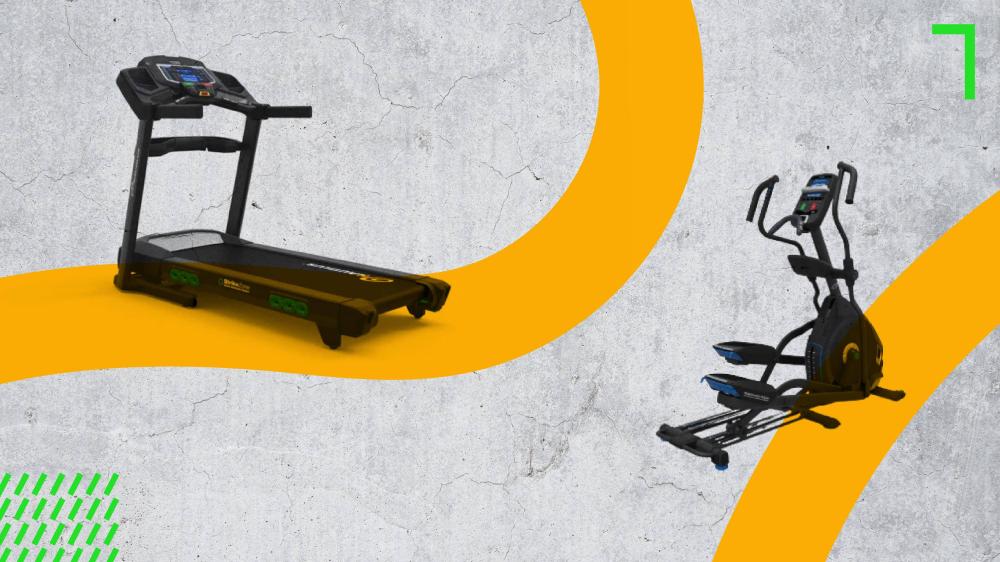In the hustle and bustle of the modern world, finding time to stay in shape can be challenging. It's no wonder that home gyms, workout classes, and fitness machines are becoming increasingly popular. When it comes to indoor cardio, treadmills and ellipticals have secured their positions as top contenders, with both offering remarkable benefits for your fitness routine. But which machine is the right one for you? In this guide, we'll break down the critical differences between treadmills and ellipticals so you can make an informed decision and take a step closer to your fitness goals.
What's The Difference Between Treadmill and Elliptical?
Treadmills are synonymous with cardiovascular fitness. Walking or running on a treadmill simulates a natural movement that has been part of human activity for centuries. By contrast, ellipticals use a more complex mechanism that combines steps and handles, yielding a low-impact yet powerful workout. When comparing the two, several factors come into play.
Mechanics and Functionality
Treadmills are straightforward—users walk, jog, or run on a flat belt that moves beneath them. The primary benefits are weight-bearing exercise that promotes bone density and engages the leg muscles.
On the other hand, elliptical machines replicate the motion of running without the impact on joints, thanks to their smooth gliding motion. The handles bring an upper-body workout into the equation, enhancing muscle engagement and calorie burn.
Impact on Health
From a cardiovascular perspective, both machines offer significant benefits. Treadmills are often preferred for high-intensity interval training (HIIT) work due to their adaptability to speed and incline changes. This can lead to higher calorie expenditure and a more robust cardiovascular workout.
Ellipticals, with their lower-impact nature, are coveted by those with joint issues or those in recovery. They offer a way to keep the heart rate up while allowing muscles to recover more quickly, making them ideal for consistent, moderate-intensity workouts.
Fitness Goals
Your fitness objectives play a pivotal role in deciding between a treadmill and an elliptical. If you're aiming for weight loss, the ability to reach high-burn zones on a treadmill typically leads to a more effective calorie burn. Alternatively, if endurance and overall body toning are your priorities, an elliptical might be the machine for you.
Both machines are staples in both home and commercial gyms, popular for their effectiveness in cardio workouts, weight loss, and improving cardiovascular health.
Advantages and Disadvantages
Each machine comes with its own set of pros and cons that can significantly impact your fitness experience.
Treadmill Advantages:
- Offers a wider range of workouts, from sprint sessions to long, steady runs.
- Mimics natural movements, which some argue is better for training in real-world conditions.
- Burns more calories per hour due to the higher intensity possible.
Treadmill Disadvantages:
- High-impact nature may cause joint discomfort and, in some cases, injury.
- The learning curve might be steeper for beginners.
Elliptical Advantages:
- Low-impact design is gentle on the joints.
- Dual-action workout targets both upper and lower body simultaneously.
- Can be operated in reverse, engaging additional muscle groups and adding workout variety.
Elliptical Disadvantages:
- Lower perceived exertion might require more time to achieve the same cardiovascular benefits.
- The fixed stride length may not be suitable for all body types, potentially leading to discomfort.
Cost and Space Considerations
Financial and spatial factors are not to be overlooked when making a decision on fitness equipment for your home gym.
Initial Investment
Treadmills and ellipticals come in a variety of models and price points. Generally, a high-quality treadmill may be more costly upfront, but with added features such as advanced cushioning systems and interactive screens. Ellipticals tend to be more affordable, especially at the entry level, while still providing a good range of workouts.
Long-Term Maintenance
Consider the long-term costs associated with upkeep. Treadmills with more mechanics may require more frequent maintenance to keep the belt running smoothly. Ellipticals, thanks to their simpler design, could offer a more budget-friendly path. They require less maintenance but still need periodic check-ups to ensure smooth operation.
Space Requirements
Treadmills, especially those with incline features, typically need more floor space. If you have a dedicated room for your home gym, this might not be a concern. However, if you're working with limited space, an elliptical's smaller footprint could be a game-changer.
Safety of Treadmills and Elliptical Machines
When considering the incorporation of either a treadmill or an elliptical into your fitness regimen, safety is a paramount concern. Both machines, when used correctly, offer a relatively safe workout environment, particularly when compared to outdoor activities that might expose you to traffic, uneven terrain, or adverse weather conditions. However, it's essential to understand the safety features and potential risks associated with each.
Treadmill Safety:
Treadmills can pose risks if not used with caution. It's crucial to start slowly, use the safety stop feature, and avoid distractions like using a phone or reading while walking or running. Treadmills demand your full attention, especially at higher speeds or inclines, to prevent slips and falls. Furthermore, children and pets should be kept away from treadmills to avoid accidents.
Elliptical Safety:
Ellipticals are generally considered low risk and are particularly suited to those with pre-existing joint conditions, due to their low-impact nature. The risk of falling off an elliptical is less than that of a treadmill, but maintaining a proper posture and grip is vital to prevent strains or overuse injuries. Like treadmills, ellipticals should be used in a clutter-free area to ensure safety.
Shared Safety Tips:
- Warm-Up and Cool Down: Always begin with a warm-up and end with a cool-down to prevent muscle strains.
- Proper Footwear: Wearing the right shoes provides support and reduces the risk of injury.
- Stay Hydrated: Exercise can be dehydrating, which can lead to dizziness or fainting; staying hydrated helps mitigate this.
- Listen to Your Body: Avoid pushing through pain, and always use machines at a level and duration that is appropriate for your fitness level.
Ultimately, the selection of a treadmill or an elliptical boils down to your own lifestyle, fitness levels, and goals. Remember, there's no one-size-fits-all in the world of fitness. Whether it's a treadmill, an elliptical, or another machine entirely, the most important step is the one you take to commit to a healthier you.
Discover the perfect match for your fitness journey with FAASporta's extensive range of treadmills and ellipticals. Whether you're looking to boost your cardiovascular health, lose weight, or enhance your endurance, we have equipment to suit every need and preference. Explore our collection today and find the machine that aligns with your personal fitness goals and lifestyle!

